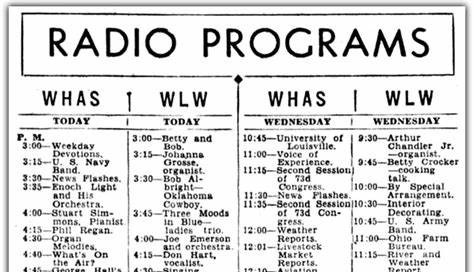WHAS Broadcasts Weather Bureau Warning and Louisville Mayor's Address
Thursday, January 21, 1937
LOUISVILLE, KENTUCKY — Today Louisville radio station WHAS mentioned the threatening floodwaters with a short announcement between the programs “Melodies and Moods” and “The Romance of Helen Trent.”
The 50,000-watt station was one of the most powerful broadcast outlets in the United States, with a signal that reached the eastern two-thirds of the country at night.
The radio announcer said:
A warning just received from the Louisville weather bureau says: ‘The Ohio Valley is facing the most alarming flood we have ever had on the Ohio River. If this rain should continue another twenty-four hours — which it doubtless will — the greatest flood in the history of the Ohio River and its tributaries is imminent. Warning! Hold yourselves in readiness to move to higher ground on a moment’s notice — and if the water is near any of your houses in lowlands, move out before nightfall!’
* * *
At 11 p.m., also on WHAS, Louisville mayor Neville Miller made an appeal to the public for calm and cooperation.
“With the flood liable to go to forty-seven feet,” the mayor said during his 15-minute statement, “now is the time to think about moving. If your home is below 450 feet above sea level, it will be invaded. If you move early, it can be done with less trouble and more safety.”
The mayor encouraged citizens who lived on higher ground to “open their homes for friends that may be driven out.” To that end, he asked “the fortunate” to send their names, addresses and how they could help to City Hall.
Miller said flood headquarters were set up in Louisville’s east and west ends. Organizations such as churches, the Red Cross, Salvation Army and the Volunteers of America were working together to help those in distress.
A Life of Public Service
The son of Shackelford and Mary Miller, Neville Miller was a native Louisvillian born in February 1894. He graduated from Louisville Male High School in 1912 and in 1916 earned a bachelor’s degree from Princeton University, where he managed the swim team and played varsity soccer.
Shackelford Miller had been Chief Justice of the Kentucky Court of Appeals. The elder Miller also practiced law at his own firm.
“His father,” wrote historian David Welky, “a respected judge and an outspoken Democratic politician, raised his son to love the law and public service.”
After attaining his law degree at Harvard Law School in 1920, Neville joined the family firm working alongside his father and brother, Shackelford Jr. He became president of the Kentucky Bar Association in 1924 and taught law for a decade at the University of Louisville. That same year he married Katherine Castleman Wilson of Summit, New Jersey. The couple would have four daughters.
In 1930 Neville Miller was named the first dean of the university’s Louis D. Brandeis School of Law.
In 1933 the judge’s son ran for the office of Louisville mayor as a “New Deal” Democrat, a proponent of President Franklin Roosevelt. He won, the first Democrat to hold the mayor’s office in 16 years. Just shy of 40 years old, it had been a steady rise for Neville Miller.
Mayor Miller went to work with the goal to “transcend party lines” and “committing himself above all to good government.” He tackled corruption, cut spending, trimmed the budget and also managed to increase services with the help of federal relief money.
“He saw no contradiction in arguing simultaneously that real men raised themselves by their bootstraps and that the government should assist victims of the Depression,” Welky wrote.
The new mayor helped blacks in the segregated city. (The black community had propelled him to a slim victory.) Miller upgraded recreational areas in their neighborhoods and placed blacks in low-rung government jobs.
Miller also served as president of the Kentucky Municipal League and directed the U.S. Conference of Mayors.
Neville Miller had accomplished a lot for a man of his age. But he couldn’t predict the future, including a flood that would be the ultimate test of his leadership.
* * *
At midnight, Addison Lee Jr., vice president of the Louisville Gas & Electric Company, said Louisville should expect widespread power outages. The hope was to maintain electricity for the telephone company, hospitals, some street cars and streetlights, as well as some of his company’s power equipment.
People seeking shelter from floodwaters were settling in for the night at packed Louisville hotels. They included many New Albany and Jeffersonville residents who had crossed the Ohio River to seek the basic comfort of a safe and dry room.
More than four dozen National Guardsmen patrolled flooded areas of New Albany on this night. Streets north of Spring Street and west of State Street were under water. Many other streets throughout the city were impassable.
Indiana National Guard Telephone Log
9:15 P.M. - In New Albany, Captain Fleischer reported there was still a need for 500 cots and 2000 blankets. A warehouse and three school buildings were available as emergency shelters in Jeffersonville. A pair of officers and 45 men were deployed, with authorization to send out more. “No looting at the present time.”
However, the severity of the growing flood did not impress old-timers, as Welky noted.
“River rats ignored the dead animals and bits of houses floating past as they insisted that 1913 and 1884 had this one beat.”
Mayor Miller also maintained his trademark sunny attitude, anticipating normalcy within a couple of weeks.
“Louisville can come through this with less trouble and damage than many believe.”
The mayor was a gifted communicator whose pep talks inspired Louisvillians. But his words would have no effect on the rain or the river.
Thank you for reading. If you liked this installment, please click the 🤍.
Access the archives for the full chronology of The 1937 Flood Journal. Find a list of sources here.






Fascinating!